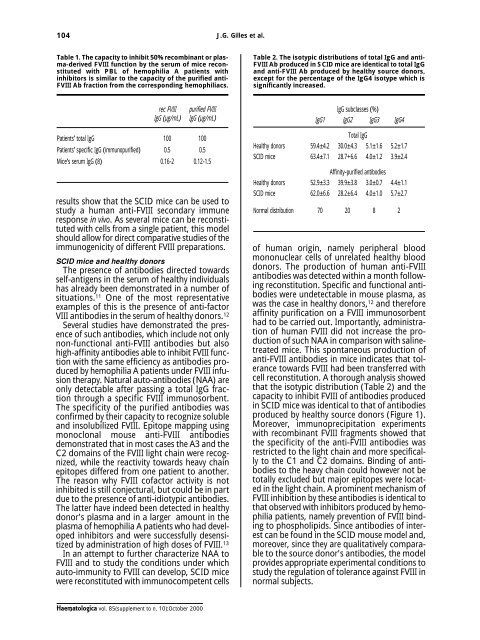Haematologica 2000;85:supplement to no. 10 - Supplements ...
Haematologica 2000;85:supplement to no. 10 - Supplements ...
Haematologica 2000;85:supplement to no. 10 - Supplements ...
You also want an ePaper? Increase the reach of your titles
YUMPU automatically turns print PDFs into web optimized ePapers that Google loves.
<strong>10</strong>4<br />
J.G. Gilles et al.<br />
Table 1. The capacity <strong>to</strong> inhibit 50% recombinant or plasma-derived<br />
FVIII function by the serum of mice reconstituted<br />
with PBL of hemophilia A patients with<br />
inhibi<strong>to</strong>rs is similar <strong>to</strong> the capacity of the purified anti-<br />
FVIII Ab fraction from the corresponding hemophiliacs.<br />
Table 2. The isotypic distributions of <strong>to</strong>tal IgG and anti-<br />
FVIII Ab produced in SCID mice are identical <strong>to</strong> <strong>to</strong>tal IgG<br />
and anti-FVIII Ab produced by healthy source do<strong>no</strong>rs,<br />
except for the percentage of the IgG4 isotype which is<br />
significantly increased.<br />
rec FVIII<br />
IgG (µg/mL)<br />
purified FVIII<br />
IgG (µg/mL)<br />
IgG subclasses (%)<br />
IgG1 IgG2 IgG3 IgG4<br />
Patients’ <strong>to</strong>tal IgG <strong>10</strong>0 <strong>10</strong>0<br />
Patients’ specific IgG (immu<strong>no</strong>purified) 0.5 0.5<br />
Mice’s serum IgG (8) 0.16-2 0.12-1.5<br />
results show that the SCID mice can be used <strong>to</strong><br />
study a human anti-FVIII secondary immune<br />
response in vivo. As several mice can be reconstituted<br />
with cells from a single patient, this model<br />
should allow for direct comparative studies of the<br />
immu<strong>no</strong>genicity of different FVIII preparations.<br />
SCID mice and healthy do<strong>no</strong>rs<br />
The presence of antibodies directed <strong>to</strong>wards<br />
self-antigens in the serum of healthy individuals<br />
has already been demonstrated in a number of<br />
situations. 11 One of the most representative<br />
examples of this is the presence of anti-fac<strong>to</strong>r<br />
VIII antibodies in the serum of healthy do<strong>no</strong>rs. 12<br />
Several studies have demonstrated the presence<br />
of such antibodies, which include <strong>no</strong>t only<br />
<strong>no</strong>n-functional anti-FVIII antibodies but also<br />
high-affinity antibodies able <strong>to</strong> inhibit FVIII function<br />
with the same efficiency as antibodies produced<br />
by hemophilia A patients under FVIII infusion<br />
therapy. Natural au<strong>to</strong>-antibodies (NAA) are<br />
only detectable after passing a <strong>to</strong>tal IgG fraction<br />
through a specific FVIII immu<strong>no</strong>sorbent.<br />
The specificity of the purified antibodies was<br />
confirmed by their capacity <strong>to</strong> recognize soluble<br />
and insolubilized FVIII. Epi<strong>to</strong>pe mapping using<br />
mo<strong>no</strong>clonal mouse anti-FVIII antibodies<br />
demonstrated that in most cases the A3 and the<br />
C2 domains of the FVIII light chain were recognized,<br />
while the reactivity <strong>to</strong>wards heavy chain<br />
epi<strong>to</strong>pes differed from one patient <strong>to</strong> a<strong>no</strong>ther.<br />
The reason why FVIII cofac<strong>to</strong>r activity is <strong>no</strong>t<br />
inhibited is still conjectural, but could be in part<br />
due <strong>to</strong> the presence of anti-idiotypic antibodies.<br />
The latter have indeed been detected in healthy<br />
do<strong>no</strong>r's plasma and in a larger amount in the<br />
plasma of hemophilia A patients who had developed<br />
inhibi<strong>to</strong>rs and were successfully desensitized<br />
by administration of high doses of FVIII. 13<br />
In an attempt <strong>to</strong> further characterize NAA <strong>to</strong><br />
FVIII and <strong>to</strong> study the conditions under which<br />
au<strong>to</strong>-immunity <strong>to</strong> FVIII can develop, SCID mice<br />
were reconstituted with immu<strong>no</strong>competent cells<br />
Total IgG<br />
Healthy do<strong>no</strong>rs 59.4±4.2 30.0±4.3 5.1±1.6 5.2±1.7<br />
SCID mice 63.4±7.1 28.7+6.6 4.0±1.2 3.9±2.4<br />
Affinity-purified antibodies<br />
Healthy do<strong>no</strong>rs 52.9±3.3 39.9±3.8 3.0±0.7 4.4±1.1<br />
SCID mice 62.0±6.6 28.2±6.4 4.0±1.0 5.7±2.7<br />
Normal distribution 70 20 8 2<br />
of human origin, namely peripheral blood<br />
mo<strong>no</strong>nuclear cells of unrelated healthy blood<br />
do<strong>no</strong>rs. The production of human anti-FVIII<br />
antibodies was detected within a month following<br />
reconstitution. Specific and functional antibodies<br />
were undetectable in mouse plasma, as<br />
was the case in healthy do<strong>no</strong>rs, 12 and therefore<br />
affinity purification on a FVIII immu<strong>no</strong>sorbent<br />
had <strong>to</strong> be carried out. Importantly, administration<br />
of human FVIII did <strong>no</strong>t increase the production<br />
of such NAA in comparison with salinetreated<br />
mice. This spontaneous production of<br />
anti-FVIII antibodies in mice indicates that <strong>to</strong>lerance<br />
<strong>to</strong>wards FVIII had been transferred with<br />
cell reconstitution. A thorough analysis showed<br />
that the isotypic distribution (Table 2) and the<br />
capacity <strong>to</strong> inhibit FVIII of antibodies produced<br />
in SCID mice was identical <strong>to</strong> that of antibodies<br />
produced by healthy source do<strong>no</strong>rs (Figure 1).<br />
Moreover, immu<strong>no</strong>precipitation experiments<br />
with recombinant FVIII fragments showed that<br />
the specificity of the anti-FVIII antibodies was<br />
restricted <strong>to</strong> the light chain and more specifically<br />
<strong>to</strong> the C1 and C2 domains. Binding of antibodies<br />
<strong>to</strong> the heavy chain could however <strong>no</strong>t be<br />
<strong>to</strong>tally excluded but major epi<strong>to</strong>pes were located<br />
in the light chain. A prominent mechanism of<br />
FVIII inhibition by these antibodies is identical <strong>to</strong><br />
that observed with inhibi<strong>to</strong>rs produced by hemophilia<br />
patients, namely prevention of FVIII binding<br />
<strong>to</strong> phospholipids. Since antibodies of interest<br />
can be found in the SCID mouse model and,<br />
moreover, since they are qualitatively comparable<br />
<strong>to</strong> the source do<strong>no</strong>r's antibodies, the model<br />
provides appropriate experimental conditions <strong>to</strong><br />
study the regulation of <strong>to</strong>lerance against FVIII in<br />
<strong>no</strong>rmal subjects.<br />
<strong>Haema<strong>to</strong>logica</strong> vol. <strong>85</strong>(<strong>supplement</strong> <strong>to</strong> n. <strong>10</strong>):Oc<strong>to</strong>ber <strong>2000</strong>
















